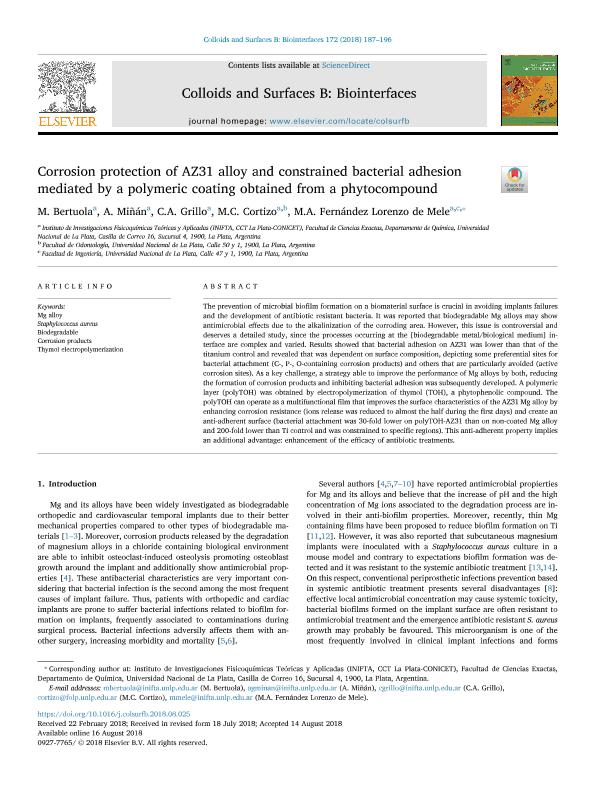Mostrar el registro sencillo del ítem
dc.contributor.author
Bertuola, Marcos

dc.contributor.author
Miñan, Alejandro Guillermo

dc.contributor.author
Grillo, Claudia Alejandra

dc.contributor.author
Salsa Cortizo, Maria Victoria

dc.contributor.author
Fernandez Lorenzo, Monica Alicia

dc.date.available
2020-03-17T19:32:44Z
dc.date.issued
2018-12
dc.identifier.citation
Bertuola, Marcos; Miñan, Alejandro Guillermo; Grillo, Claudia Alejandra; Salsa Cortizo, Maria Victoria; Fernandez Lorenzo, Monica Alicia; Corrosion protection of AZ31 alloy and constrained bacterial adhesion mediated by a polymeric coating obtained from a phytocompound; Elsevier Science; Colloids and Surfaces B: Biointerfaces; 172; 12-2018; 187-196
dc.identifier.issn
0927-7765
dc.identifier.uri
http://hdl.handle.net/11336/99898
dc.description.abstract
The prevention of microbial biofilm formation on a biomaterial surface is crucial in avoiding implants failures and the development of antibiotic resistant bacteria. It was reported that biodegradable Mg alloys may show antimicrobial effects due to the alkalinization of the corroding area. However, this issue is controversial and deserves a detailed study, since the processes occurring at the [biodegradable metal/biological medium] interface are complex and varied. Results showed that bacterial adhesion on AZ31 was lower than that of the titanium control and revealed that was dependent on surface composition, depicting some preferential sites for bacterial attachment (C-, P-, O-containing corrosion products) and others that are particularly avoided (active corrosion sites). As a key challenge, a strategy able to improve the performance of Mg alloys by both, reducing the formation of corrosion products and inhibiting bacterial adhesion was subsequently developed. A polymeric layer (polyTOH) was obtained by electropolymerization of thymol (TOH), a phytophenolic compound. The polyTOH can operate as a multifunctional film that improves the surface characteristics of the AZ31 Mg alloy by enhancing corrosion resistance (ions release was reduced to almost the half during the first days) and create an anti-adherent surface (bacterial attachment was 30-fold lower on polyTOH-AZ31 than on non-coated Mg alloy and 200-fold lower than Ti control and was constrained to specific regions). This anti-adherent property implies an additional advantage: enhancement of the efficacy of antibiotic treatments.
dc.format
application/pdf
dc.language.iso
eng
dc.publisher
Elsevier Science

dc.rights
info:eu-repo/semantics/openAccess
dc.rights.uri
https://creativecommons.org/licenses/by-nc-sa/2.5/ar/
dc.subject
BIODEGRADABLE
dc.subject
CORROSION PRODUCTS
dc.subject
MG ALLOY
dc.subject
STAPHYLOCOCCUS AUREUS
dc.subject
THYMOL ELECTROPOLYMERIZATION
dc.subject.classification
Biomateriales

dc.subject.classification
Biotecnología de la Salud

dc.subject.classification
CIENCIAS MÉDICAS Y DE LA SALUD

dc.title
Corrosion protection of AZ31 alloy and constrained bacterial adhesion mediated by a polymeric coating obtained from a phytocompound
dc.type
info:eu-repo/semantics/article
dc.type
info:ar-repo/semantics/artículo
dc.type
info:eu-repo/semantics/publishedVersion
dc.date.updated
2020-03-16T14:01:14Z
dc.journal.volume
172
dc.journal.pagination
187-196
dc.journal.pais
Países Bajos

dc.journal.ciudad
Amsterdam
dc.description.fil
Fil: Bertuola, Marcos. Consejo Nacional de Investigaciones Científicas y Técnicas. Centro Científico Tecnológico Conicet - La Plata. Instituto de Investigaciones Fisicoquímicas Teóricas y Aplicadas. Universidad Nacional de La Plata. Facultad de Ciencias Exactas. Instituto de Investigaciones Fisicoquímicas Teóricas y Aplicadas; Argentina
dc.description.fil
Fil: Miñan, Alejandro Guillermo. Consejo Nacional de Investigaciones Científicas y Técnicas. Centro Científico Tecnológico Conicet - La Plata. Instituto de Investigaciones Fisicoquímicas Teóricas y Aplicadas. Universidad Nacional de La Plata. Facultad de Ciencias Exactas. Instituto de Investigaciones Fisicoquímicas Teóricas y Aplicadas; Argentina
dc.description.fil
Fil: Grillo, Claudia Alejandra. Consejo Nacional de Investigaciones Científicas y Técnicas. Centro Científico Tecnológico Conicet - La Plata. Instituto de Investigaciones Fisicoquímicas Teóricas y Aplicadas. Universidad Nacional de La Plata. Facultad de Ciencias Exactas. Instituto de Investigaciones Fisicoquímicas Teóricas y Aplicadas; Argentina
dc.description.fil
Fil: Salsa Cortizo, Maria Victoria. Universidad Nacional de La Plata. Facultad de Odontología; Argentina. Consejo Nacional de Investigaciones Científicas y Técnicas. Centro Científico Tecnológico Conicet - La Plata. Instituto de Investigaciones Fisicoquímicas Teóricas y Aplicadas. Universidad Nacional de La Plata. Facultad de Ciencias Exactas. Instituto de Investigaciones Fisicoquímicas Teóricas y Aplicadas; Argentina
dc.description.fil
Fil: Fernandez Lorenzo, Monica Alicia. Consejo Nacional de Investigaciones Científicas y Técnicas. Centro Científico Tecnológico Conicet - La Plata. Instituto de Investigaciones Fisicoquímicas Teóricas y Aplicadas. Universidad Nacional de La Plata. Facultad de Ciencias Exactas. Instituto de Investigaciones Fisicoquímicas Teóricas y Aplicadas; Argentina. Universidad Nacional de La Plata. Facultad de Ingeniería; Argentina
dc.journal.title
Colloids and Surfaces B: Biointerfaces

dc.relation.alternativeid
info:eu-repo/semantics/altIdentifier/url/https://linkinghub.elsevier.com/retrieve/pii/S0927776518305563
dc.relation.alternativeid
info:eu-repo/semantics/altIdentifier/doi/http://dx.doi.org/10.1016/j.colsurfb.2018.08.025
Archivos asociados
